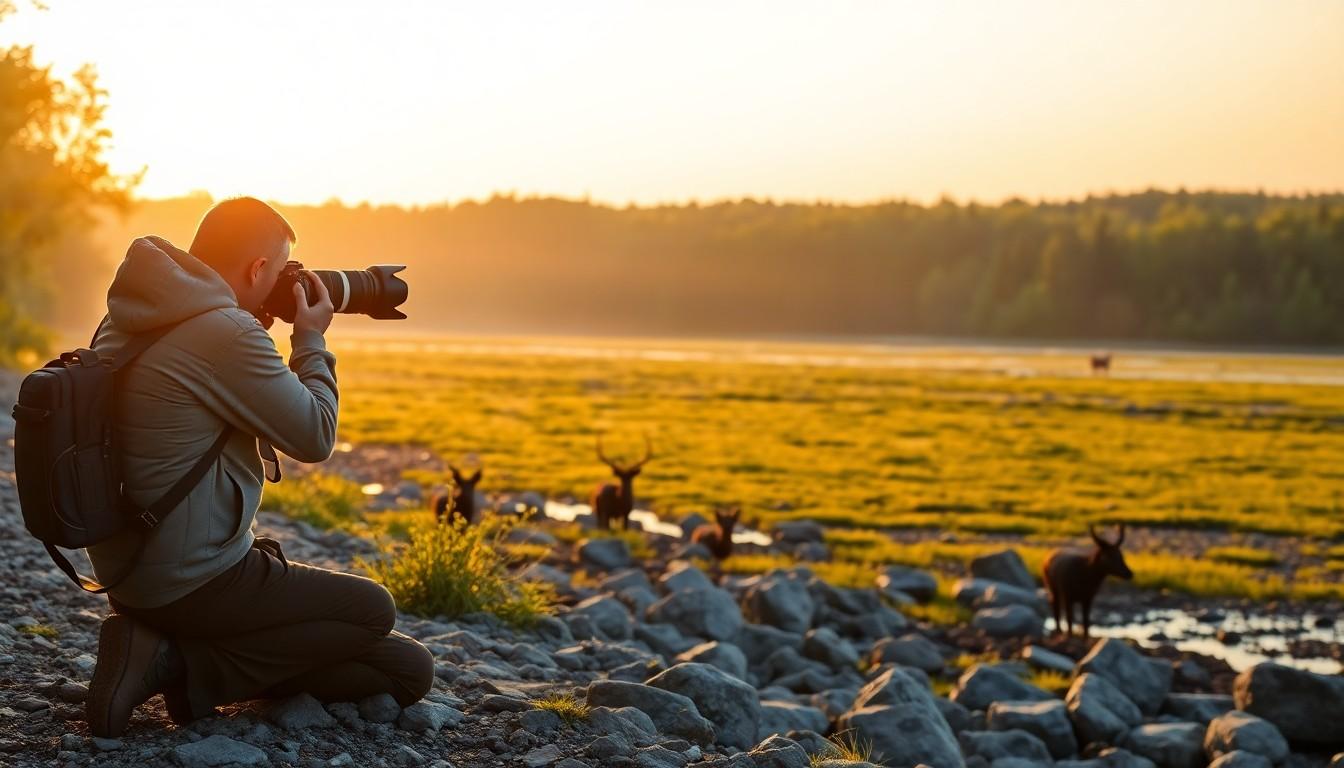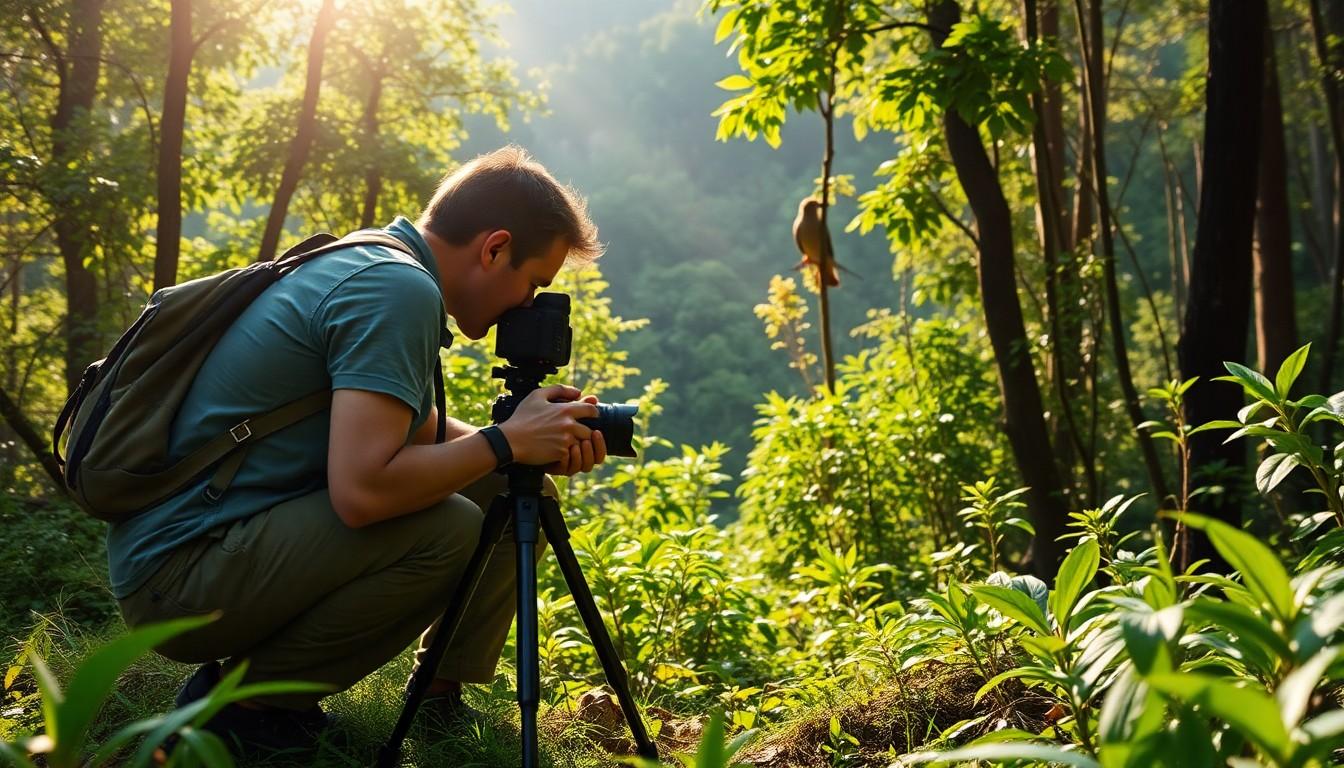Nature conservation photography isn’t just about snapping pretty pictures; it’s a powerful tool for change. Imagine capturing the breathtaking beauty of a vibrant forest or the delicate dance of a butterfly, then using those images to inspire action. It’s like being a superhero with a camera, fighting for the planet one click at a time.
Nature Conservation Photography
Nature conservation photography encompasses more than just artistic imagery. It serves as a vital medium for showcasing the beauty of ecosystems while advocating for their protection.
Definition and Scope
Nature conservation photography involves capturing images that highlight natural environments and wildlife. Photographers often focus on endangered species, pristine landscapes, or areas affected by environmental degradation. This genre promotes a deeper appreciation for nature by providing visual narratives that engage viewers. Numerous photographers seek to document biodiversity and ecological processes to underline the importance of conservation efforts. Capturing these moments can foster emotional connections between people and nature.
Importance in Environmental Awareness
Nature conservation photography plays a crucial role in raising awareness about environmental issues. By presenting striking images, it inspires audiences to recognize the urgency of climate change, habitat destruction, and species extinction. Visual storytelling can motivate individuals and communities to support conservation initiatives. Research indicates that compelling photographs significantly increase public interest in environmental topics. Engaging imagery not only serves as a call to action but also drives fundraising and volunteer efforts for conservation projects.
Techniques and Tools
Nature conservation photography requires specific techniques and tools to achieve impactful results. Understanding the right camera equipment and composition strategies enhances the ability to convey important environmental messages.
Camera Equipment Essentials
Choosing the right camera can significantly affect image quality. DSLRs and mirrorless models offer flexibility and control, allowing adjustments in various lighting conditions. Lenses play a vital role as well; wide-angle lenses capture expansive landscapes while telephoto lenses help photograph wildlife from a distance. Tripods provide stability, crucial for long-exposure shots, especially in low-light environments. Utilize filters to manage reflections, enhance colors, and protect lenses from dirt and moisture. Regular equipment maintenance ensures reliability during crucial shooting moments.
Composition Tips for Impactful Images
Effective composition can transform an ordinary photo into a compelling narrative. Using the rule of thirds helps draw viewers’ eyes to focal points within the frame. Incorporating leading lines leads viewers through the image, creating depth and interest. Including foreground elements adds context and dimension. Natural light enhances textures and colors, so plan shoots for golden hours when sunlight is softer. Capturing unique angles reveals familiar subjects in new ways, making them more engaging. Finally, persistence in photographing endangered species or vulnerable habitats raises awareness through powerful visual storytelling.
Notable Nature Conservation Photographers
Numerous photographers have made significant impacts in nature conservation photography. Their work highlights the urgent need for environmental preservation.
Icons in the Field
Renowned photographers like Frans Lanting and Art Wolfe stand out for their captivating images and commitment to conservation. Lanting’s work often emphasizes endangered species and the intricate relationships within ecosystems. He’s dedicated numerous projects to showcasing the beauty and fragility of nature. Wolfe, known for his vivid landscapes, incorporates a focus on wildlife and natural environments that inspire awe. Both photographers use their platforms to advocate for environmental awareness and action, sparking conversations about conservation. Their imagery captures the essence of nature and encourages the public to appreciate and protect the planet.
Emerging Talents
New talent continues to emerge in the field of nature conservation photography. Photographers such as Lauren Kearns and David Tipling are gaining recognition for their innovative approaches. Kearns focuses on the interconnectivity of ecosystems, highlighting lesser-known species and habitats. Tipling, specializing in avian photography, promotes bird conservation through striking visuals. Young photographers use social media to showcase their work, reaching wider audiences and building strong communities. Their fresh perspectives contribute to ongoing dialogues about the environment. By sharing their unique visions, they inspire others to take part in conservation efforts and advocate for a sustainable future.
The Role of Social Media
Social media plays a vital role in amplifying the impact of nature conservation photography. It serves as a platform for photographers to share compelling images and crucial messages about environmental issues.
Sharing Conservation Messages
Effective conservation messages resonate with audiences when paired with stunning visuals. Photographers can leverage captions, hashtags, and engaging stories to enhance the narrative behind their images. By highlighting specific environmental challenges, they can solicit support from viewers and inspire collective action. Notably, campaigns featuring powerful imagery often go viral, increasing awareness among diverse audiences. Conservation messages also encourage conversation and foster a sense of community around shared environmental goals.
Popular Platforms for Photographers
Various social media platforms cater to nature conservation photographers, each with unique advantages. Instagram shines as a visual-centric platform, providing a space for vibrant imagery and brief messages. Photographers can utilize Stories and Reels to showcase behind-the-scenes moments and engage followers. Facebook offers broader community-building opportunities, enabling groups focused on conservation discussions. Twitter serves as a tool for real-time updates, connecting photographers with environmental organizations and activists. TikTok allows for creative storytelling, reaching younger audiences through captivating short videos. Collectively, these platforms expand the reach of conservation efforts and engage a global audience.
Challenges in Nature Conservation Photography
Nature conservation photography faces several challenges that can impede its effectiveness. Navigating ethical considerations plays a crucial role in this field.
Ethical Considerations
Photographers must prioritize the welfare of ecosystems and wildlife. Disturbing habitats or stressing animals for the perfect shot contradicts conservation efforts. Professionals often adopt guidelines from organizations like the International League of Conservation Photographers. Ethical practices involve minimizing human footprints while capturing images. Respecting local communities is equally vital; engaging with them fosters collaboration and ensures that their perspectives are honored. By doing so, photographers not only promote ethical conduct, they also build rapport within conservation efforts.
Environmental Impact
Nature conservation photography can inadvertently affect the very environments it seeks to protect. Increased foot traffic from photographers takes a toll on fragile habitats. Trailing wildlife might prompt behaviors that disrupt natural routines. Maintaining a delicate balance between capturing stunning visuals and minimizing disturbance remains essential. Many photographers emphasize the use of remote cameras or drones to limit human presence. Techniques like these help document wildlife without causing harm. Understanding the environmental impact of photography ensures actions taken align with conservation goals.
Protecting our Planet
Nature conservation photography plays a crucial role in fostering a deeper connection between people and the environment. It not only captures the beauty of the natural world but also serves as a catalyst for change. Through compelling visuals and powerful narratives, photographers inspire action and raise awareness about pressing environmental issues.
As the field continues to evolve, the integration of ethical practices and innovative techniques will enhance its impact. By leveraging social media platforms, photographers can reach wider audiences and engage them in meaningful conversations about conservation. Ultimately, nature conservation photography is more than an art form; it’s a vital tool for protecting our planet and promoting a sustainable future for generations to come.


